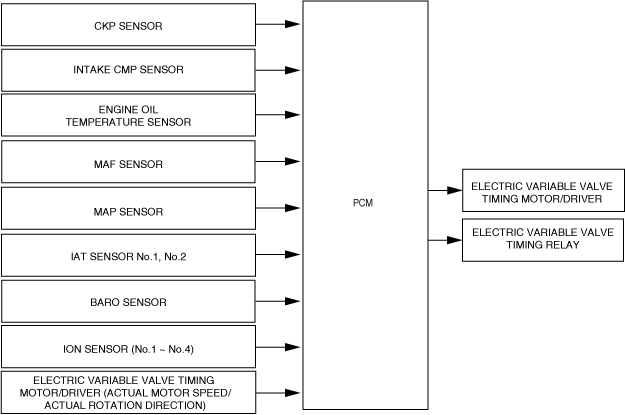ELECTRIC VARIABLE VALVE TIMING CONTROL [SKYACTIV-G (WITHOUT CYLINDER DEACTIVATION (US))]
ELECTRIC VARIABLE VALVE TIMING CONTROL [SKYACTIV-G (WITHOUT CYLINDER DEACTIVATION (US))]
SM2565345
id0140u0318100
Outline
Block Diagram
atsuzn00000502
|
Operation
Intake valve timing determination
-
• The PCM determines the optimum target intake valve timing according to the engine operation conditions, and controls the output duty ratio to the electric variable valve timing driver so that the actual intake valve timing approaches close to the target intake valve timing.
-
Target valve timing
-
• The target intake valve timing is determined according to the engine speed, charging efficiency, and engine coolant temperature.
-
Actual valve timing
-
• The actual intake valve timing is calculated by adding a correction, which is based on the electric variable valve timing actuator signal value, to the value calculated by subtracting the cam maximum retard learning value from the standard intake valve timing.• The standard intake valve timing is calculated based on the signals from the crankshaft position and camshaft position sensors.
-
Cam maximum retard learning value
-
• The cam maximum retard learning value is determined by the maximum retard indication output from the PCM and the standard intake valve timing when the standard intake valve timing is stabilized.
Output duty ratio determination
-
• The PCM divides the electric variable valve timing motor drive range modes according to the engine operation conditions, and determines the output duty ratio to the electric variable valve timing actuator in each mode.
|
Mode name |
Control description |
Control conditions |
|---|---|---|
|
Feedback mode
|
• Continuously monitors the intake valve timing if it matches the target intake valve timing determined according to the engine operation condition, and controls the output duty ratio based on the result.
|
• Except for energization cut mode and phase holding mode
|
|
Energization cut mode
|
• If there is any malfunction in the electric variable valve timing driver, the intake valve timing is held at the maximum retard position to stabilize the engine speed.
|
• Electric variable valve timing driver malfunction
|
|
Phase holding mode
|
• To improve the startability, the phase of the electric variable valve timing actuator is held at the intermediate position after the engine is stopped.
|
• After the engine is stopped (Depending on the engine coolant temperature, operates after a certain period has elapsed from when the engine was stopped to suppress heating of the electrical variable valve timing motor.)
|
